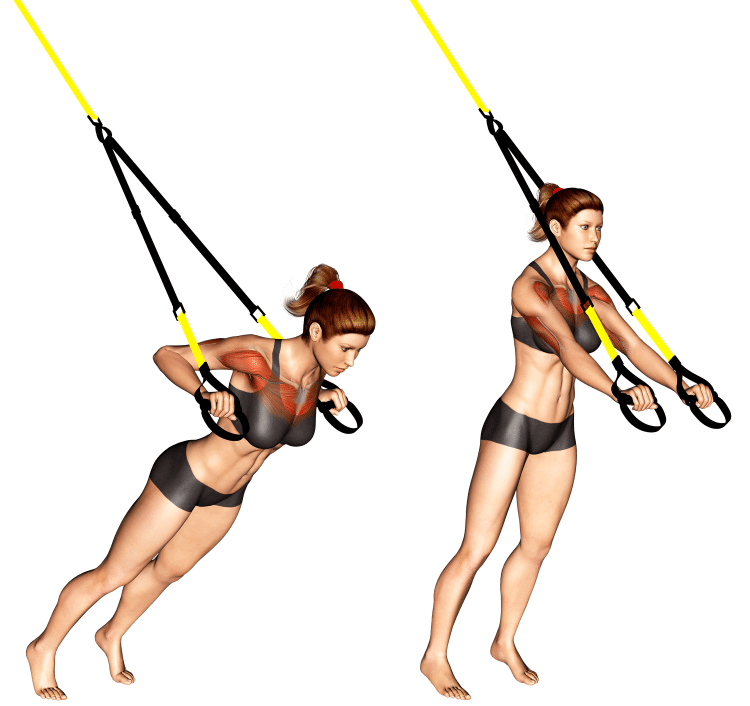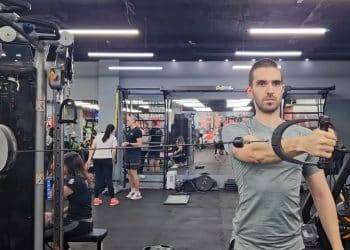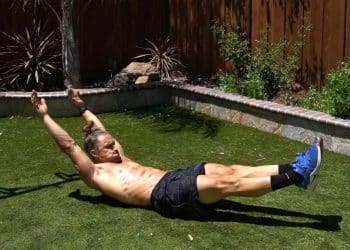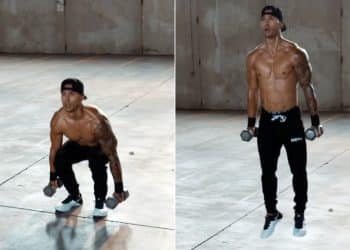The suspension push-up is a bodyweight-based exercise that utilizes high-hanging straps with handles to provide resistance during different muscle and strength-building exercises. The famous TRX trainer and its alternatives were designed with functional training benefits in mind, as the free-moving ends create instability, forcing you to engage more total body activation than you would during the more common, supported versions of chest presses like push-ups, bench presses, machine presses, and even cable variations. And that is exactly what makes it a unique training method, and hence a more functional strategy to build your chest muscle, strength, and power gains!
In this guide, you’ll probably learn about some benefits of suspension trainers that you never thought of. We’ll show you how to do a proper suspension chest press, go over the common mistakes, and leave you with the best variations and alternatives of this super exercise!
Muscles Worked During The Suspension Chest Press
Let’s learn some anatomy of your three key push muscles that make suspension chest presses possible.

Pectoralis major clavicular and sternal heads
While there’s no way to train one part of your chest, you can emphasize the upper or lower part with incline and decline angles, respectively. While beginners should stick with the fundamentals basics of push-up form during suspension push-ups, more advanced exercises are more capable of shifting the focus toward the clavicular, sternal, or overall chest.
Deltoid anterior
A push requires not just potent chesticles but the forward arm action of your front deltoids, or one of the three heads that creates your shoulder muscles.
Triceps brachii
Capable of powerful elbow extension, you can only achieve your best press with strong triceps that accompany powerful pecs. And that’s thanks to three heads (Long, medial, and lateral) that cover the back and side of the upper arm and provide lots of muscle power during push movements.
Level Up Your Fitness: Join our 💪 strong community in Fitness Volt Newsletter. Get daily inspiration, expert-backed workouts, nutrition tips, the latest in strength sports, and the support you need to reach your goals. Subscribe for free!
How To Do The Suspension Chest Press
A bit different from your standard gym class push-up, adding suspension straps creates an unstable environment which requires more attention to detail. Not just for best results, but to safeguard your chest and delts.
Here below are the detailed steps you need for safe and effective suspension chest press performance. You’ll also find a brief video demonstration and explanation of the technique too!
Step 1: Adjust your straps to the appropriate height relative to your strength ability or desired level of difficulty for a given workout session.
Step 2: Grip the handles with the straps on the outside or inside of your arms, depending which is most comfortable for you.
Step 3: Keep your arms fully extended and lean your weight forward onto the straps while gripping the handles firmly. Tighten your core muscles, glutes, and quadriceps to maintain a strong neutral body position.
Step 4: Determine if you need to adjust the straps or your stance to create more or less resistance. A more upright body angle reduces the resistance and makes the exercise easier.
Step 5: Next, bend your elbows then lower your chest down between the straps while maintaining control as you descend. Stop when you achieve the desired stretch in your chest muscles. Be careful not to go too far down that it starts causing discomfort in your shoulders.
Pro tip: Avoid flaring your elbows too wide as it’s not recommended for healthy shoulders, or optimal pushing performance.
Step 6: Now, when you perform the press, squeeze your chest, push into the handles to extend the arms, and pull your hands together for the ultimate chest contraction!
Repeat steps 4 and 5 for the optimal number of repetitions.
Pro Tips
- If you need more resistance, wear a weighted vest (Ideal), or backpack loaded with weighted objects (Make sure the weight is loaded evenly for symmetrical development). Just make sure the straps are rated for the desired resistance loading.
- A more upright stance creates less resistance. If you want a more challenging workout, move your feet back further away from your hands. Likewise, the higher the straps, the more upright your body will be naturally. Drop them lower if you want to increase strength and muscle gains. But make this progress gradual, and train according to your experience level.
- You don’t need to lower yourself as low as you can to get a beneficial stretch in your chest. In fact, this can place a lot of unnecessary stress on your shoulders with no added advantage.
This Exercise
- Target muscle group: Pectoralis major
- Type: Hypertrophy and strength
- Mechanics: Compound
- Equipment: Suspension straps
- Difficulty: Intermediate
- Sets and reps: 3 x failure
Benefits Of The Suspension Chest Press
There are a few clear advantages of suspension chest presses compared to a basic floor push-up and even suspension push-ups, which hang the feet above the ground.
A more functional dumbbell chest press alternative
It’s more functional because your entire body is activated, moving, and trying to keep stabilized during the suspension chest press. Not supported by a bench like a dumbbell press, or having your hands and feet in contact with the floor like in a push-up. Therefore, you need to activate a little more mental focus.
And a study comparing muscle activation during floor push-ups vs. suspension chest press found higher core activation in the suspension chest press variation (1).
Related: Suspension train bodybuilding workout plan
Nail the stretch!
A normal floor push-up doesn’t stretch the chest nearly the same as something like a suspension chest press. That’s because the ground limits how far you can go down. Whereas straps offer unlimited range of motion. And there’s not a credible expert on this planet that wouldn’t agree on the importance of stretching your muscles under a training load.
But science has also shown the negatives to be a necessary component for getting those muscle gains (2).
Total body
You can’t just relax yourself in a suspension chest press the way you could during machine chest presses. You have to engage everything from your toes to pretty much every muscles group in your body to stabilize, and create a strong base for the suspension chest press.
Add a layer of chest protection
Training yourself in a shaky, unstable movement can help to create a chest more resilient to injuries. Especially beneficial for athletes, performing sports-related activities can involve asymmetrical and unstable use of your muscles, and this can spell bad news. So it may pay to get used to training your muscles using various methods that challenge all aspects of your capabilities.
Strengthen your rotator cuff/shoulders
The rotator cuff muscles surround and hence stabilize the shoulder joint which allows us to move the arms in various positions. And you can strengthen them like any other muscle and, in turn, it’ll benefit your delt health, and extend the life of your shoulder function.
You can do it at home
If you only workout at home and a gym setup is not an option, why not invest in a suspension trainer? Sure you could use bands but they’re two different tools and hence offer unique advantages over the other. It’s minimalist in design, can be used outdoors too, and the angles and positions to train from are limitless.
Common Mistakes During The Suspension Chest Press
You definitely don’t want to adopt these bad habits when performing the suspension chest press.
Dropping down on the negative
You don’t want to do this especially when using suspension straps. Not just because you’re wasting a perfectly good eccentric or negative repetition. But you can quickly tear your pec muscle. While suspension chest presses give you the “stretch” which is a huge plus, it can be a double edged sword if you’re not careful.
Sinking hips
You never want the hips to sag during a push-up aimed at building the chest. Why? It’s sloppy form that shifts the movement away from strong chest press technique.
Not getting that adduction action!
One advantage that suspension chest presses have over suspension push-ups is the ability to adduct the arms. Or in layman’s terms, bringing the arms together during the press for a better chest squeeze. And gains come from contracting the muscles against a resistance load. Not to mention, you’ll hit deeper fibers, especially toward the inner pecs!
8 Variations And Alternatives of The Suspension Chest Press
These variations are excellent alternatives to the suspension chest press. Most are unilateral, and unstable, while one is focused on an incline position to replicate the angle of suspension chest presses.
Level Up Your Fitness: Join our 💪 strong community in Fitness Volt Newsletter. Get daily inspiration, expert-backed workouts, nutrition tips, the latest in strength sports, and the support you need to reach your goals. Subscribe for free!
Weighted suspension chest press
An overlooked technique, in our opinion, is putting on a weighted vest or loading up a training bag or backpack with symmetrical resistance to add more weight to an exercise. This is a perfectly effective way to keep making gains since progressive overload is a must, especially when you train at home with limited equipment.
So if you find that your suspension chest presses are becoming too easy, or you can pump out endless reps, add a little more resistance gradually in small weight increments. But make sure your straps are rated to support the weight load.
One arm suspension chest press
You thought you were going to get off easy, didn’t you? Well, we’re starting off nice and heavy on you… literally. One arm movements feel heavier because you’re supporting all of your weight on just one arm instead of two, which makes the exercise significantly more challenging.
You’ll have to focus on keeping your shoulders forward, not rotating, and keeping your arm close to your side to protect your shoulders.
This is how the single arm suspension chest press should look in motion…
Pro tip: Make your feet wide to create a stable base, however, too wide and you may be overcompensating for a lack of adequate strength to safely and effectively perform this variation.
Suspension push-up
We just wrote a full guide on the suspension push-up, an opposite end focused variation of the suspension chest press. Hanging the feet off the ground rather than the upper body, you’ll be forced to engage more core and leg power for efficient force transfer, and hence total body gains. This could unlock serious benefits for anyone from athletes to the regular gym goer, and people who train at home or prefer calisthenics based workouts.
Dumbbell chest press
You should be using dumbbells to train the large muscles in your upper body such as the chest, back, and shoulders.
Why?
Dumbbells train you to stabilize the body and mind in a way that allows you to generate maximum force during an unstable technique.
Additionally, if one side is lagging behind, you can more easily pinpoint the cause and fix it.
And a bonus of pressing dumbbells is that they require little setup and you can grab and go which is beneficial for things like drop sets, and preserving energy for subsequent sets (Not having to remove and load plates on a barbell bench press).
Learn how to do the dumbbell bench press here.
Incline push-up
While the decline push increases the resistance, an incline press up is more of a beginner variation. It’ll be easier than a suspension chest press as you have more stability, performing the movement against an object like a wall, countertop, bench, etc. But it’s performed at a similar angle to the suspension chest press.
Read how to get better at push-ups.
Ring push-up
While less realistic than using a TRX trainer but not incredibly rare to find in a gym, the difference in how it feels to grip a ring vs handles can be significant that one would prefer either over the other. Similar in terms of stabilization requirements, and the ability to adduct your arms.
Also a gymnastics based movement, ring push-ups are usually taught to include what’s called ring turn out (RTO). Upon pressing the arms straight, you’ll rotate the palms to face forward. This enhances the difficulty while strengthening the position for carryover to other common ring techniques.
You can see what we’re talking about in the included video clip below.
Suspension chest fly
While it’s a different exercise with a different goal, we can’t talk about suspension chest movement without mentioning the mighty fly. After all, there’s no exercise technique quite like it. And if you polled gym goers and asked them what exercise gives them the most satisfying pump and contraction without being painful and agonizing (Ahemm seated leg extensions), we’d bet the chest fly comes out on top!
Now the difference here is that the fly involves bringing the arms even further apart to stretch every fiber from the inner to outer chest. You’ll then pull the arms together creating the most skin tearing contraction that lights up every fiber in those pecs! It also tends to drive more blood in there, making you feel like King Kong when you walk out of the gym.
To do it:
- Assume the same starting position as the suspension chest press.
- Find the appropriate body angle relative to your strength ability (More upright is easier).
- Maintain a straight body, tense your core and engage the glutes, and quadriceps. Your head should be in line with the rest of your body, not tilted back or sticking out in front of you.
- Keeping a slight bend in your elbows, open your arms out wide as to form a cross with your body, and slowly lower yourself down toward the floor.
- Stop when your arms are roughly lateral to your body, not bringing them too far behind you. Unless you’re advanced and can safely get into a deeper chest stretch.
- Now contract your chest muscles together, pull the arms together, and touch your hands together while squeezing the pecs as hard as you can.
That’s one rep! Keep going until you finish the first set.
Pro tip: Use a neutral grip for best control, chest contraction, and protecting the shoulders.
Sets/reps: 3 x 10-12
Cable standing chest press
If you do these heavy enough, they’ll challenge your stability like a suspension chest press. However, you’ll need to engage the abs for a different reason, to keep your body anchored down against the machine pulleys trying to pull you backwards. Then your left and right side has to fight against the resistance independent of one another, then throw in the free moving nature of cable machines, and you’ve got a battle in your hands.
So once again, you don’t get to set up on a comfy platform like a bench, machine, or even in a push-up position. You’re being challenges all over the place.
We recently put together a detailed guide on the cable standing chest press!
FAQ’s
How many sets and reps should I be doing for suspension chest presses?
Typically, for any exercise, you want to perform a minimum two working sets per session. And depending on your training frequency, three sets per workout is typically optimal for most exercises.
But… you also have to factor in level of training experience, overall routine (Number of exercises you’re performing per muscle group) and also the time you have available to train.
As for reps, we recommend combining near failure and complete failure sets, either stopping a few reps short of your set max, or training until you cannot achieve any more repetitions. That’s because suspension chest presses are a bodyweight exercise, and you cannot adjust the resistance unless you change your body angle.
Therefore, doing as many as you can seems to work best. However, if you can do more than 25 reps, we suggest modifying your body position, strapping on a weighted vest, or wearing a loaded backpack.
How do I choose suspension straps for training?
Any quality suspension straps will be more than suitable for your bodyweight training needs. While the TRX brand is most famous and high quality, you can find other great alternative options on the market too.
Make sure to read the product description, check out user reviews, and we recommend buying from a reputable, well known company in fitness equipment for optimal safety and performance.
How many times per week should I use suspension straps to train my chest muscles?
This depends on a few different factors like individual training preferences, where you train, which training methods you prefer, and your training routine.
Keep in mind your goals, training volume/weight loads, general sets and rep recommendations, and how long it takes for a muscle to recover in between workouts. Then you can determine how to use your suspension trainer to help you reach your chest building potential.
Wrapping Up
If you ever thought about how you could level up your workouts especially if you train outside of a gym, look no further than the proven suspension trainer. It offers so many additional benefits including that it’s a portable training system that gives you more range of motion for all body parts compared to floor based exercises. Hence allowing you to take advantage of the stretch phase of a repetition. Then you have more angles and positions to train from, making your options almost limitless.
The suspension chest press is one of the OG suspension-based exercises that challenges the chest, triceps, and front delts like no other training implement! But there are some downsides which are actually upsides, like the unstable nature of training on free moving straps which enhances physical, functional, and mental performance. So if you’re an athlete, suspension chest presses can strengthen and safeguard your pushing muscles against positions that could cause injuries.
Interested in measuring your progress? Check out our strength standards for Bench Press, Push Ups, Dumbbell Bench Press, and more.











